What Is Cross Country Skiing?
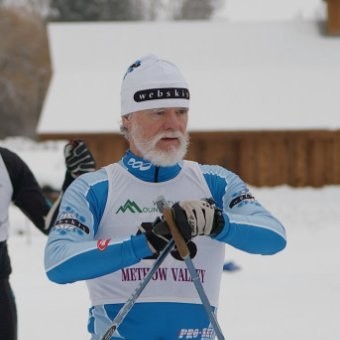
Author: Bert Hinkley, ski guru at Webcyclery
Last updated: November 2023
Guide Overview
Nordic skiing, more commonly referred to as cross country or XC skiing, is an increasingly popular winter sport, and in this guide we’ll be going over everything you need to know to get started. Throughout this guide we'll use the terms Nordic and Cross Country and interchangeably.
So what’s in this guide?
Here’s the rundown of this helpful guide to nordic (or cross country) skiing:
- We’ll start by defining what cross country skiing is and why people love it.
- After that we’ll explain the different styles and how you can decide which one suits you best.
- From there, we’ll go over the equipment you need to start your own nordic adventures.
- Finally, we'll provide a bunch of resources you can explore to learn more.
What is cross country skiing?
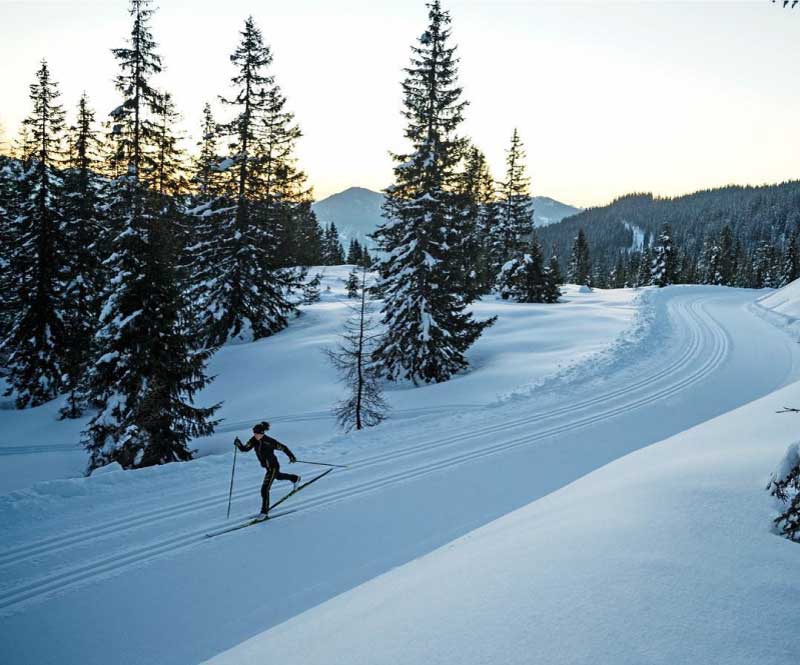
Cross country skiing is a great way to stay in shape and have fun during the winter months while offering a vastly different experience to the crowds and steep slopes of alpine skiing, also called downhill skiing.
Instead of taking a chair lift to the top of a mountain and quickly skiing back down as you do with downhill skiing, cross country skiing is most often performed on rolling terrain and without a lift.
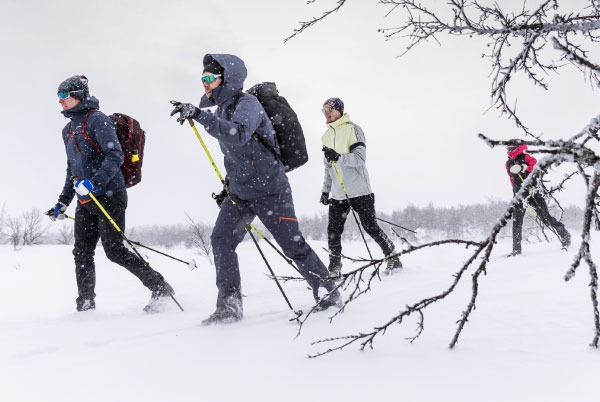
Cross country skiing involves skis that feature a free heel.
This means that only the front of the boot attaches to the binding, allowing the skier's heel to lift off the ski in order to efficiently slide forward through the snow.
Nordic skiing has a variety of applications, from light exercise, to racing, to backcountry exploration.
You can go cross country skiing at resorts and public lands on maintained trails and tracks or out on your own.
Why do people love cross country skiing?
There are tons of great reasons to get excited about cross country skiing. Here’s some of the most common ones:
- It’s a great workout.
Cross country skiing is great exercise. Depending on the style you choose, it can be more similar to hiking, running, or skating, all of which will certainly get your heart rate up and put a smile on your face. - It’s a low impact activity.
While downhill skiing can put a lot of strain on your knees and other parts of your body, cross country skiing is often less jarring and causes fewer injuries. - It’s very safe.
Many people are intimidated by the steep slopes and higher speeds of downhill skiing and feel much more confident with the gentler gradients and slower speeds associated with nordic. - It’s refreshingly quiet.
Cross country is a great way to avoid the crowded slopes and long lift lines. Nordic ski areas are typically open, less crowded, and generally more peaceful than traditional downhill skiing resorts. - It’s affordable.
While getting the necessary equipment is an investment, nordic ski passes are very affordable and you won’t be paying hundreds of dollars every year in expensive lift tickets. - It’s versatile.
There are lots of different ways to go cross country skiing. Beginners and advanced skiers will all find an activity that suits them. You can slowly cruise through scenic vistas on dedicated tracks, you can skate faster laps and race around groomed trails, and you can explore off the beaten path and discover new places. There’s truly something for everyone.
What are the different styles of cross country skiing?
For starters, let’s clear up some of the questions surrounding the naming conventions of nordic skiing.
Nordic and cross country are two terms that can be used interchangeably as the parent category of the styles we’re about to explain.
There are two main styles of cross country skiing, classic and skate, and just about every subset of cross country skiing can be grouped into these two categories.
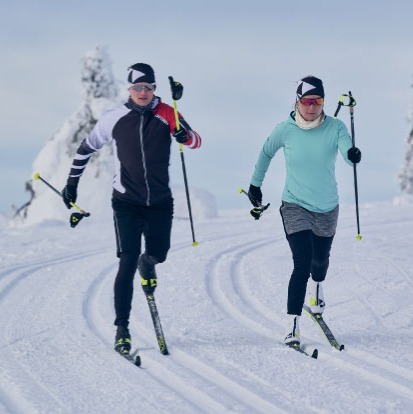
Classic Cross Country Skiing
Track
Classic XC skiing can be done on maintained courses where skiers move through established tracks.
Typically, this style of XC skiing is done at ski resorts or on public lands specifically designed for nordic skiing.
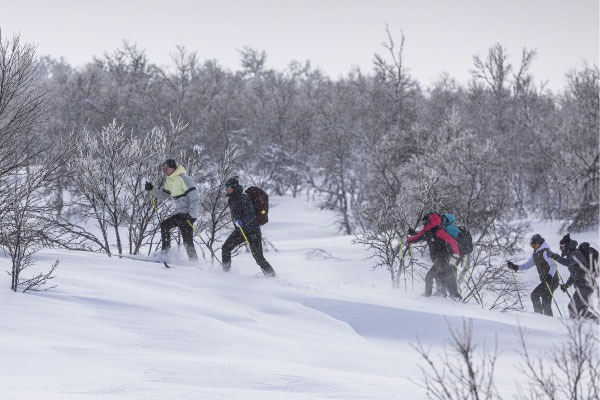
Off-Track
Classic XC skiing can also be done “off-track”, where skiers are able to move more freely around their environment.
This style is more similar to the historical “cross country” skiing that helped nordic people move from place to place in winter.
Instead of fixed tracks, these skiers can more freely enjoy maintained trails, as well as navigate forests, valleys, and hills.

Skate Skiing
Skate is the other main category of nordic skiing. Classic skiing is more similar to hiking, while skate skiing is a bit more like running.
Skate skiing is perfect for those who like to go a little faster and get more of a workout. Instead of sliding forwards and backwards, skate skiing is accomplished by pushing off your edge in a V-shaped position.
Skate skiing is done on professionally groomed, hard-packed tracks. If you’ve watched the winter olympics, you’ve probably seen this style on its biggest stage.
Which type of cross country skiing is best for you?
Skate Skiing
Skate style cross country skiing is one of the best ways to stay in great shape throughout winter. It’s fast and fun, and you’re sure to get your heart racing in the best way possible. You’ll need to visit a resort or publicly maintained track to take advantage of this style. If you have racing aspirations or you just want a killer workout, skate skiing is a perfect choice.
On-Track Classic Skiing
If you’re just starting out, you’ll probably want to stick to classic on-track style skiing. It’s the easiest way to learn the basics and get comfortable with free heel skis. If you’re looking for a simple way to get some fresh air and a little exercise, you’ll probably love this style. You’ll head to a resort or public trail system and follow the maintained track around bends and meander up and down gentle gradients while practicing your technique and balance.
Classic Cross Country Ski Touring
For those who enjoy the classic style but have a bit more experience, you might love cross country touring. You can ski groomed trails if you choose, but the main benefit is the ability to blaze your own trail, explore more scenic areas, and ski more challenging terrain.
Classic Nordic Backcountry Skiing
Backcountry nordic skiing is similar to classic touring, except the skis are wider and made of burlier material in order to handle rougher terrain, steeper inclines, and more adventurous outings. If you have a strong background in cross country skiing, you’ll enjoy the ability to skin your way up into the backcountry and confidently carve your way back down.
What equipment do you need for XC skiing?
Here's a list of the most important gear you'll need for cross country skiing:
- Cross Country Skis: there are different types of skis for skate and classic
- Cross Country Ski Boots: xc ski boots keep you comfortable and agile
- Cross Country Ski Bindings: bindings connect your boots to your skis
- Cross Country Ski Poles: you use xc ski poles to propel yourself forward
- Ski Wax: xc ski wax helps your skis move through the snow efficiently
- Cross Country Ski Clothing: wearing the right clothing is essential
Resources & Helpful Links
Here's a list of helpful resources and that you can explore to learn more about cross country skiing:
- How To Cross Country Ski
- Cross Country Ski Size Chart
- Cross Country Ski Boot Size Chart
- Cross Country Ski Pole Size Chart
- Why Cross Country Skiing Is Great Exercise
- Popular Nordic Ski Areas Near Bend, Oregon
- Types Of Cross Country Skiing
- What Are Skin Skis
- Understanding Ski Flex
- Ski Wax 101
- Introduction to Rollerskiing
Enjoy the winter with cross country skiing
We hope this guide will help you with your nordic skiing questions and that you give cross country a try this winter. At WebCyclery and WebSkis we are happy to help you pick the best equipment for your goals, so don’t hesitate to drop us a line!
